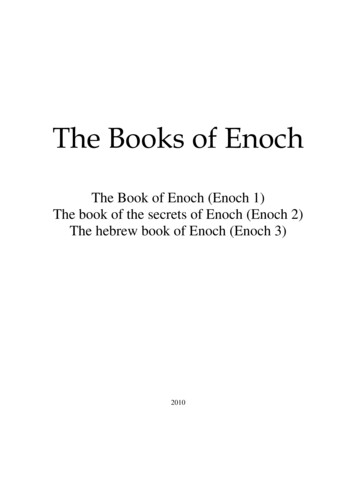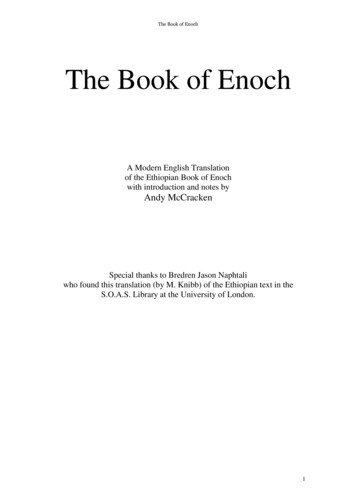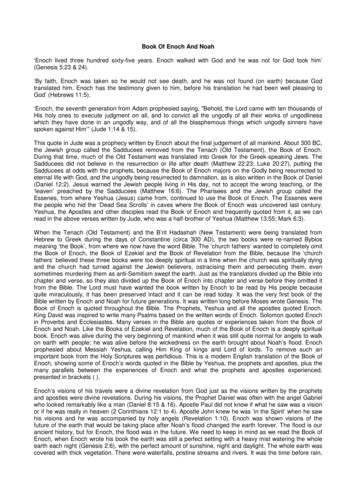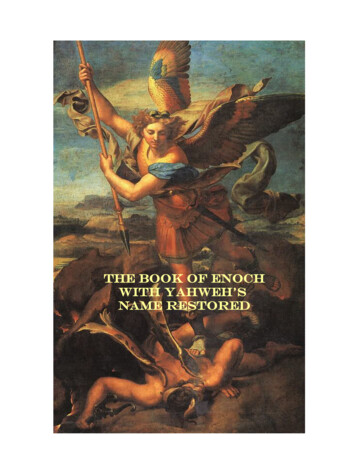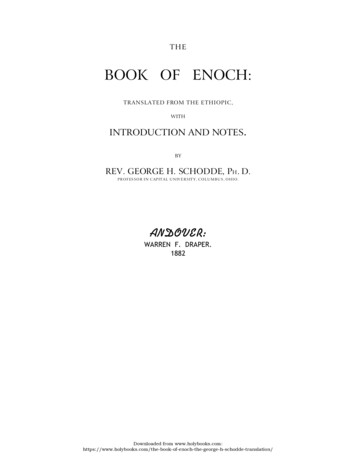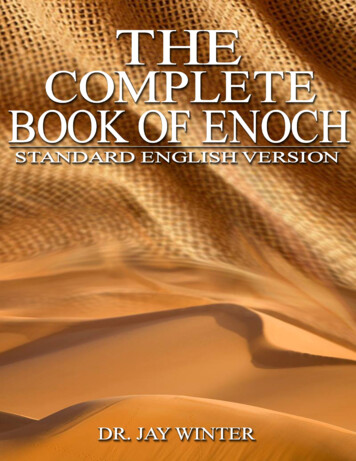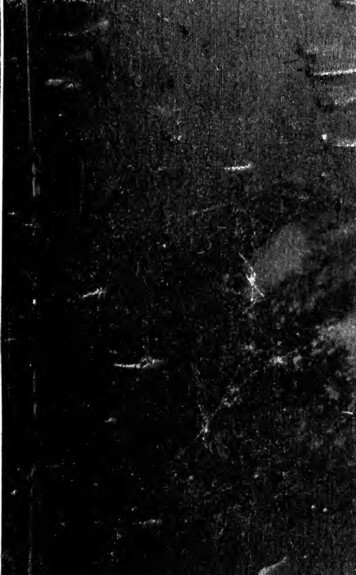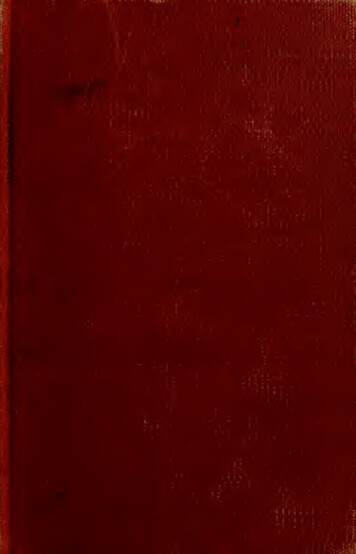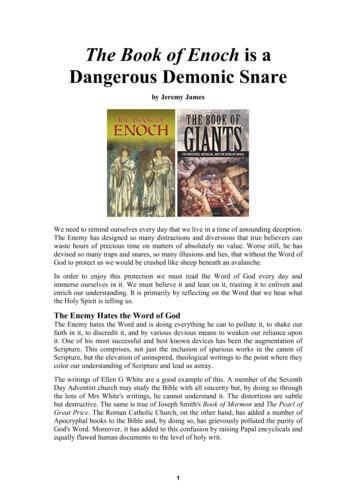
Transcription
The Book of Enoch is aDangerous Demonic Snareby Jeremy JamesWe need to remind ourselves every day that we live in a time of astounding deception.The Enemy has designed so many distractions and diversions that true believers canwaste hours of precious time on matters of absolutely no value. Worse still, he hasdevised so many traps and snares, so many illusions and lies, that without the Word ofGod to protect us we would be crushed like sheep beneath an avalanche.In order to enjoy this protection we must read the Word of God every day andimmerse ourselves in it. We must believe it and lean on it, trusting it to enliven andenrich our understanding. It is primarily by reflecting on the Word that we hear whatthe Holy Spirit is telling us.The Enemy Hates the Word of GodThe Enemy hates the Word and is doing everything he can to pollute it, to shake ourfaith in it, to discredit it, and by various devious means to weaken our reliance uponit. One of his most successful and best known devices has been the augmentation ofScripture. This comprises, not just the inclusion of spurious works in the canon ofScripture, but the elevation of uninspired, theological writings to the point where theycolor our understanding of Scripture and lead us astray.The writings of Ellen G White are a good example of this. A member of the SeventhDay Adventist church may study the Bible with all sincerity but, by doing so throughthe lens of Mrs White's writings, he cannot understand it. The distortions are subtlebut destructive. The same is true of Joseph Smith's Book of Mormon and The Pearl ofGreat Price. The Roman Catholic Church, on the other hand, has added a number ofApocryphal books to the Bible and, by doing so, has grievously polluted the purity ofGod's Word. Moreover, it has added to this confusion by raising Papal encyclicals andequally flawed human documents to the level of holy writ.1
Any book that dominates one's understanding of Scripture can have a similar effect.In this paper we will examine one of the most dangerous of these duplicitous works,the so-called Book of Enoch.The Book of MormonThe Great ControversyThe Book of EnochBackgroundAt the outset it should be understood that The Book of Enoch is really five separatebooks by different authors, bound together as a single work comprising 108 chapters.The first book, chapters 1-36, deals with The Watchers and the ephilim.It is undoubtedly the one that exercises the greatest influence over modernspeculative writing. The Watchers are a group of fallen angels, while theNephilim are the offspring produced from their sexual union with women.The second book, chapters 37-71, contains The Parables of Enoch. Thereare three parables in all. The first deals with the nature of heaven, thesecond with the Enochian concept of a messiah, and the third with thenature of the earth.The third book, consisting mainly of chapters 72-82, deals withastronomy and the movement of the heavenly bodies.The fourth book, chapters 83-90, contains an apocalyptic vision of theFlood, a vision of the millennial kingdom, and the history of Israel to thetime of the Maccabees, expressed as events that had yet to happen.The fifth book, chapters 91-108, also called the Epistle of Enoch, containsadmonitions to his children, as well as prophetic reflections on thedestinies of the righteous and the wicked, respectively.The Book of Enoch (presumably comprising all five books, though no-one knows forcertain) was familiar to post-Apostolic writers, some of whom seem to have regardedit as genuine, though how this affected their interpretation of Scripture is also unclear.However, when the constituent books of the Bible were selected and endorsed by theecclesiastic authorities in the fourth century AD, The Book of Enoch was not included.It remained forgotten until its rediscovery over a thousand years later.2
The Book of Enoch was at no time part of the Jewish canon of Scripture and was notincluded in the Septuagint, the Greek translation of the Old Testament which wascompleted around 130 BC. [Hereafter, when we speak of The Book of Enoch, wemean all five books, except where a lesser number is indicated.]The only complete version of the 'book' (i.e. books 1-5 in a single volume) is in Ge'ezor Ethiopian, dating from the 16th century or thereabouts. Copies of this version werediscovered by the Scottish explorer, James Bruce, in 1773 and brought back toEurope. The first translation in English was not published until 1821.The Dead Sea Scrolls contain fragments in Aramaic from four of the books (Nofragments from The Book of Parables were identified). These fragments containenough text to allow their place in The Book of Enoch to be determined, but not nearlyenough to confirm that the version found by Bruce is substantially the same as the oneon which the Qumran fragments were based.Scholars have made a tentative estimate of the periods in which the books werewritten. No scholar of repute, as far as we know, attributes the work as a whole toEnoch, the son of Jared, mentioned in Genesis 5:18. It is universally agreed that, likevirtually all Apocryphal literature, the Book of Enoch was written in what is oftencalled the inter-testamental period, after the last of the Old Testament books had beenwritten (c.400 BC) but before the appearance of the earliest works of the NewTestament. Such works were often made attractive to naïve readers by falselyattributing them to a person of note, such as Solomon, Noah or Enoch. A similartechnique was used later to propagate the so-called Gnostic gospels, where boguswritings were attributed to the Apostles, such as The Gospel of Thomas, The Gospel ofPhilip, or The Apocalypse of Paul.While there is seemingly no consensus as yet as to when each of the five 'books' werewritten, it is generally agreed that portions may pre-date the Maccabean revolt of 167BC, while other parts may have been penned in the first century BC but before thearrival of the Romans in 63 BC. The Book of Parables, on the other hand, wasprobably written late in the first century A.D.3
The attack on God's Word has been ongoing, not just in Apostolic times andthereafter, but from the Babylonian Exile, if not before. For example, during the Exilean influential group of apostate Jews initiated the Talmudic tradition in whichcommentaries by learned rabbis were taken to be as authoritative as Scripture. Jesusberated the Pharisees for elevating their "traditions" in this way: "Full well ye rejectthe commandment of God, that ye may keep your own tradition." (Mark 7:9) He evendescribed them as a generation of vipers and serpents (Matthew 23:33). In light of thiswe should hardly be surprised that these various hypocritical and apostate groupswere willing to give credence to works which had no place in the canon of Scripture.God preserves His WordGod said He would preserve His Word. The canon of Scripture was closed in 96 ADor thereabouts when John completed the Book of Revelation. In doing so John wouldhave been able to confirm for his disciples the contents or constituent books of theNew Testment, as well as those of the Bible as a whole. The Roman Catholic Churchlikes to perpetuate the myth that the contents of the New Testament were not finallydetermined until the 4th century A.D., but she does this primarily to assert her holdover the Bible.When John penned Revelation 22, the last chapter in the book (and the Bible), he wasformally closing the canon of Scripture and, in doing so, must have known exactlywhat that canon was:"For I testify unto every man that heareth the words of the prophecy ofthis book, If any man shall add unto these things, God shall add unto himthe plagues that are written in this book: And if any man shall take awayfrom the words of the book of this prophecy, God shall take away his partout of the book of life, and out of the holy city, and from the things whichare written in this book." (Revelation 22:18-19)Since God's Word is an organic whole, we know that these verses apply to the Bibleas a whole and not just to the Book of Revelation. This means that, from the start ofthe 2nd century, the church, the body of true believers, knew exactly which bookswere in the Bible. The Book of Enoch was not one of them.4
The modern fascination with The Book of EnochToday The Book of Enoch has come to be regarded by many as a book that "should"have been in the Bible but was inexplicably excluded. Its admirers claim that itanswers so many questions and fills in so many gaps in our knowledge that it must betrue. Even early Apostolic writers spoke well of it, including Clement of Alexandria,Irenaeus, and Tertullian. Furthermore, since there is no record of why it was excludedfrom the Bible, they argue that it must have been dropped for purely political reasons.Many contend that it was actively suppressed by the Roman Catholic Church since itcontained ideas that were inconsistent with Catholic theology. Some even believe thatGod allowed it to disappear until our modern age when it contents would be vital toour understanding of prophecy and the well-being of the End Time church.There is an entire industry devoted to this book, with one prophecy conference afteranother extolling its revelatory gems. The literature relating to this book is quiteextraordinary. Numerous popular authors, including many who claim to be Christian,continue to produce books and videos which treat The Book of Enoch as a factualhistorical text.A major prophecy conference held in July 2016 in Colorado Springs – a popularlocation for New Age, esoteric, and occult events – featured a long list of speakerswho are pushing the Nephilim agenda, including Tom Horn, Gary Stearman, L AMarzulli, Doc Marquis, Cris Putnam, Josh Peck, Michael Lake, Ken Johnson, DerekGilbert, and Stan Deyo. Similar prophecy conferences in the past have included suchwell-known Nephilim aficionados as Chuck Missler, Russ Dizdar, Rob Skiba, DougHamp, and Michael Heiser.In addition to those who profess to be 'Christian', there are many teachers and socalled prophets of the New Age who offer a ringing endorsement of The Book ofEnoch. Why? Because it fits perfectly with the New Age vision of the future, where'highly evolved' beings come to earth from another 'galaxy' to save our 'planet' fromdestruction and lift the 'initiated' remnant into a state of 'cosmic consciousness'.5
The 3ephilim DeceptionWe addressed the question of the Nephilim, ETs and UFOs in some earlier papers,including:The Great ephilim Deception:Why Christians are Being Tricked into Believing in ETs and UFOs (#49),The Jesuit-controlled ET Deception is Rapidly Taking Shape (#62),Fatal Flaws in the Gap Theory:Why the Earth and the Heavens are around Six Thousand Years Old (#85),The Curse of ew Age Christianity:Chuck Missler and His 'Holographic' Universe (#55)We would refer the reader to these for an analysis of the great Nephilim deception andrelated matters. Meanwhile, we will confine ourselves in this paper to The Book ofEnoch itself, the common source of many of these false teachings.Reasons why The Book of Enoch is a fakeThere are so many reasons to reject The Book of Enoch, not simply as a book thatshould be excluded from the Bible, but as a book that cannot be trusted on any level.Let's start with the reasons for excluding it from the Bible:Imagination, not inspiration1. It was plainly part of the archive of Aramaic literature that blossomed after thereturn from the Babylonian exile. The Jews had been exposed to a wealth of paganideas in Babylon, and then to the Zoroastrian philosophy of the Persians and Medesafter the fall of Babylon in 539 BC. With the rise of the Seleucid empire and thegradual Hellenization of many Jewish communities, the mythology of Greece and themetaphysics of Plato left their mark on the Jewish imagination. The former wassteeped in tales of women mating with the gods of Mount Olympus to produce humanoffspring that possessed supernatural abilities. Greek mythology was also replete withstories of hybrids that were part animal and part human.6
Several authors speaking in the first person2. The Book of Enoch was originally five separate works by different authors, allspeaking in the first person. Apart from the later inclusion of a few editorial passagesto link them together, they have no continuity of thought and no connection with themessage of the Bible or with the progressive revelation that we find in Scripture.What is even more striking is the extent to which it ignores Biblical truth, and innumerous places makes statements that actually conflict with what Scripture hasrevealed.A false god3. The Book of Enoch makes no convincing reference to the God of the Bible. Its 'god'is the god of Plato and Greek metaphysics, a god with whom man cannot have apersonal relationship. As some commentators have noted, the god of 'Enoch' is verysimilar to the Great Architect of Freemasonry.A false doctrine of sin4. The Book of Enoch teaches a deeply heretical concept of sin, one that makes acomplete mockery of Biblical revelation. As far as its various authors are concerned,sin entered the world through the fallen angels. Mankind was the victim of an angelicinvasion which fatally polluted the human germline and produced – in a way that isnever clearly explained – a sharp demarcation between the righteous and the wicked.At some future date a messiah-type figure will emerge who will purge the earth of thelatter and usher in the millennium.A purely human messiah5. The messiah-type figure in The Book of Enoch is not the Messiah of the Bible – ofIsaiah, Zechariah, and the Psalms. There is only a tentative portrayal of him as asaviour and no indication whatever that he is divine.7
3o doctrine of Redemption6. Without the Biblical doctrine of sin, The Book of Enoch never teaches, or evenimplies, that sin is repugnant to an awesomely Holy God or that man, in his fallenstate, is completely alienated from God and needs a Redeemer. Rather earth is seen asa battleground in which good eventually triumphs over evil, where grace and mercyhave no real meaning, and where death itself is but a phase in a cosmic struggle. Theidea that sin must be punished and that the wages of sin is death is completely alien tothe strange theology running through this book.3ot part of the Jewish canon7. The Book of Enoch was never part of the Jewish canon of Scripture and was neverrecognized by Christians as part of Scripture.Reasons why this book is simply not trustworthyNow let's examine the integrity of this book from an historical standpoint. Eventhough it is not part of the canon of Scripture and was not divinely inspired, is itpossible that some of what it teaches is factually correct? For example, did it set out inwritten form an oral tradition that had been handed down for centuries from the timeof Noah and, to that extent, rather like the First Book of Maccabees, contains materialbased on actual events?As we shall see, the evidence clearly shows that The Book of Enoch is unreliable onevery level. Here are some further reasons for rejecting the book in its totality, inaddition to those already cited above:1. It was not written by the son of JaredThe book masquerades as a work by Enoch, the son of Jared and grandfather of Noah,who lived more than three thousand years earlier. This shows that its authors wereattempting to pass off as a true prophetic work a fictional composition of their owndevising. Had the work been based on a long-established oral tradition and written inthe third person, there would have been no need to engage in such a deception. So,either it was a bona fide copy of a document written three thousand years earlier byEnoch, or it was a deliberate fraud. The problem with fraudulent material is that noneof its contents can be trusted. We have no way of knowing whether some parts, if any,were either factually true or based on actual events.8
2. We don't know the source of Jude's quotationDefenders of The Book of Enoch like to point to the quotation in the book of Jude andargue that, if Jude quoted Enoch, he must have been acknowledging the historicalaccuracy of the work known as The Book of Enoch:"And Enoch also, the seventh from Adam, prophesied of these, saying,Behold, the Lord cometh with ten thousands of his saints, To executejudgment upon all, and to convince all that are ungodly among them of alltheir ungodly deeds which they have ungodly committed, and of all theirhard speeches which ungodly sinners have spoken against him."(Jude 1:14-15)We know Enoch said this because the Bible tells us so. Where? In Jude 1:14-15. Wehave no way of knowing whether Jude consulted a text known as The Book of Enoch,that he regarded it as part of the canon of Scripture, or that he endorsed any other partof the book. All we know is that the Holy Spirit inspired Jude to include thatquotation and its attribution in his letter.Paul quoted Epimenides (without attribution) in Titus 1:12 ("All Cretans are liars")but we do not for a moment imagine that he was recommending the writings ofEpimenides, a pagan, or that any part of his writings would edify believers.3. Angels are spiritsDefenders of The Book of Enoch also like to point to another verse in Jude, along witha similar verse in 2 Peter, and claim that the angels in question were the Watcherswhich fathered the Nephilim :"And the angels which kept not their first estate, but left their ownhabitation, he hath reserved in everlasting chains under darkness unto thejudgment of the great day." (Jude 1:6)"For if God spared not the angels that sinned, but cast them down to hell,and delivered them into chains of darkness, to be reserved unto judgment;"(2 Peter 2:4)9
It is a longstanding principle of Biblical interpretation that no verse of Scriptureshould be read in isolation, especially where a doctrinal issue is concerned. We mustcompare scripture with scripture and discount interpretations that conflict with what isplainly stated elsewhere. The Word of God tells us that angels are spirits:"Who maketh his angels spirits; his ministers a flaming fire:" (Psalm 104:4)"And of the angels he saith, Who maketh his angels spirits, and his ministersa flame of fire." (Hebrews 1:7)"But to which of the angels said he at any time, Sit on my right hand, until Imake thine enemies thy footstool? Are they not all ministering spirits, sentforth to minister for them who shall be heirs of salvation?" (Hebrews 1:14)Angels also differ from humans in that they were all brought into existence at thesame time. There was no need for them to procreate since their total number was fixedfor all time by God when He created them. Jesus was referring to this when he said:"For in the resurrection they neither marry, nor are given in marriage,but are as the angels of God in heaven." (Matthew 22:30)If angels cannot procreate among their own kind, they certainly cannot do so withhumans. They have no genetic seed by which they can transmit their image, and asspirits have no corporeal component. Therefore the idea that angels mated withhumans at any time is simply absurd.Let's look at the principal text that the Nephilim promoters use to justify their falsebelief:"And it came to pass, when men began to multiply on the face of the earth, anddaughters were born unto them, That the sons of God saw the daughters of menthat they were fair; and they took them wives of all which they chose. And theLORD said, My spirit shall not always strive with man, for that he also is flesh:yet his days shall be an hundred and twenty years. There were giants in theearth in those days; and also after that, when the sons of God came in unto thedaughters of men, and they bare children to them, the same became mighty menwhich were of old, men of renown. And GOD saw that the wickedness of manwas great in the earth, and that every imagination of the thoughts of his heartwas only evil continually. And it repented the LORD that he had made man onthe earth, and it grieved him at his heart." (Genesis 6:1-6)10
All of this occurred within the lifetimes of just two people, Adam and Methuselah.What is more their lifetimes overlapped by 243 years – see chart above.Everybody alive on earth at the time of the Flood was closely related to one of the tenmen in the chart above. We are literally speaking of a massive population consistingmainly of cousins and grandchildren. We know from the dreadful breach thatoccurred between Cain and Abel that there existed two religious systems at the time,one which accepted the need for a Redeemer and one which did not. The old Biblecommentators called the former group the Sethites since, like Seth (brother of Abel),they sought a relationship with God ("And to Seth, to him also there was born a son;and he called his name Enos: then began men to call upon the name of the LORD." Genesis 4:26).The generations of AdamThe Bible makes a sharp distinction between the Sethites and the descendants ofCain. We can see this clearly in Genesis Chapter 5 which opens with the words:"This is the book of the generations of Adam. In the day that God createdman, in the likeness of God made he him; Male and female created he them;and blessed them, and called their name Adam, in the day when they werecreated. And Adam lived an hundred and thirty years, and begat a son in hisown likeness, after his image; and called his name Seth:" (Genesis 5:1-3)The ten men named in the above chart are all listed in "the book of the generations ofAdam", but the descendants of Cain are not. They are named instead in Chapter 4:Enoch (not to be confused with the son of Jared), Irad, Mehujael, Methusael (not tobe confused with Methuselah), Lamech (not to be confused with the son ofMethuselah), and the sons of Lamech – Jabal, Jubal, and Tubalcain.Thus the earth for many years comprised two distinct religious groups, the Sethites orchildren of God – because they called upon the name of the LORD (Genesis 4:26)and accepted that they were made in the image of God, just like Seth (Genesis 5:3) –and the Cainites, who are described as the children of men because they did not callupon the name of the LORD and did not accept that they were made in His image.Remains of the golden calf altar at Dan built by Jeroboam11
The Sethites, the chosen people of their age, soon did what the Israelites did a fewthousand years later – they intermarried with pagan women ("the daughters of men.")Instead of remaining separate they allowed themselves to intermingle with thechildren of disobedience. This had disastrous consequences, and wickedness quicklyspread across the earth.The children produced by these unions seemed to carry great influence in both campsand became "mighty men, men of renown". The spiritual vitality of the Sethitesquickly waned as these "mighty men" led them further into Cainite depravity. As aresult "the wickedness of man was great in the earth, and every imagination of thethoughts of his heart was only evil continually." (Genesis 6:5)Stature is not necessarily physicalThe Hebrew words in Genesis 6:4, which are translated "giants" and "mighty men" inthe KJV, refer to stature. The context tells us that this related to their politicalstanding, their stature as leaders of men and thus their instrumental role in leading theSethites down the path of depravity.We find the same history repeating itself in the story of Israel, where intermarriagewith pagans and a failure to separate completely from false religious practices led to arapid departure from the path of righteousness. This was accelerated by theemergence of powerful political figures ("mighty men") like Jeroboam, who institutedthe worship of golden calves, and Ahaz, whose marriage to Jezebel led to Baalworship and vicious religious persecution.We don't need to invent giants and hybrid offspring to understand what washappening in Genesis 6. In fact, an interpretation based on giants and hybrid offspringis entirely inconsistent with the context and with the socio-political conditions beingdescribed.4. There are no hybrid spiritsDefenders of The Book of Enoch also like to argue that the unclean spirits which Jesusexpelled from his followers came originally from dead hybrids. They reject the notionthat the demons or unclean spirits of the Bible were fallen angels, perhaps of thelowest order. Instead they speculate – based on chapter 15 – that the spirits of deadNephilim, being neither fully human nor fully angelic, had no designated place to gowhen their physical body died and were obliged instead to wander the earth lookingfor another body to inhabit. In some variations of this story, the unclean spirits werenot those of the Nephilim themselves but of the part-human, part-animal hybrids thatthe Nephilim produced via genetic experimentation.12
However, they are wrong. In the order established by God, both the spirit of man andthe spirit of animals have a designated place: "Who knoweth the spirit of man thatgoeth upward, and the spirit of the beast that goeth downward to the earth?"(Ecclesiastes 3:21) Neither wander the earth after death. The Nephilim hybrid,combining human and animal tissue, must have had either a human or an animalspirit. As such it had a designated place, neither of which entailed wandering the earthafter death.5. Similitude is not incarnationIn their vain to attempt to convince themselves that the fallen angels can mate withhumans, the defenders of The Book of Enoch point out that angels assumed physicalform on several occasions in the Bible. They reason that, if angels can assumephysical form at certain times, then they are capable of mating with human women.This is nonsensical reasoning. Firstly, the angels in the Bible who appeared to men inphysical form were not incarnate in human form. They were not made of human fleshbut were a similitude only. The Angel of the LORD, who appeared to Elijah andothers, was Christ in human form, but not yet incarnate in human flesh.The righteous angels in the Bible are called messengers because they were sent byGod. The Hebrew word for angel, malak, and the Greek, angelos, both mean"messenger". This means they were authorised by God on such occasions to appear toman in human form. There is no indication anywhere in the Bible that angels, whetherfallen or righteous, can appear to man without approval from God. The very name,messenger, is an indication of this fact.Consistency is an important principle of Bible interpretationBefore we go on to consider why the false teaching of the Nephilim is being promotedso strongly today, we will look first at a few examples of the numerous statements inThe Book of Enoch which conflict in some way with the Word of God.Defenders of this egregious book like to imagine that, since it was allegedly pennedby Enoch before the rest of the Bible was written, it did not have to be fully consistentwith the revelation that came later. But this is absurd! The Holy Spirit is the author ofthe Word of God and, as such, everything He says must be consistent. He could neverhave said anything in The Book of Enoch (had He inspired it) that was not perfectlyconsistent with what He would reveal later through the prophets. This alone showsthat The Book of Enoch is a fraudulent work and should be rejected outright bybelievers in God's Word.13
Heresies in Chapters 1-5Take the opening chapters (1-5) which describe the work of creation and conditionson earth after the Tribulation. There is no indication here that the Son of Godincarnates and lives thereafter among the righteous. Salvation merely means living in"light and grace and peace". While the author does envisage the absence of sin and thedesire to sin, he goes on to say "they will complete the number of the days of their lifeand their lives shall be increased in peace" (4.9) This is an outcome that could just aseasily have arisen without a Messiah, without salvation, and without anyreconciliation between God and man. He also confuses the millennium with theeternal state and deals with the question of sin in an infantile way, as something thatwill simply no longer exist. The staggering price that must be paid to achieve this isnot even hinted at. These chapters (1-5) read more like a fairytale than a vital part ofGod's revelation to man.Heresies in Chapters 6-11Okay, let's look at the next six chapters (6-11). These are without doubt the ones thathave contributed most to the notoriety of The Book of Enoch by twisting the plaininterpretation of Genesis 6 into a science fiction drama. It begins with two hundredangels conspiring together to invade earth and make wives of human women. Thefollowing statement is attributed to 'Semjaza', the leader of this renegade group: "Ifear ye will not indeed agree to do this deed, and I alone shall have to pay the penaltyof a great sin." In all 19 of these fallen angels are named (6:7), none of whom arementioned in the Bible. Given that only two fallen angels are named in the Bible,Lucifer/Satan and Abaddon/Apollyon, and only two righteous angels, Gabriel andMichael, we find here an obvious attempt to portray these rebels in heroic orsympathetic terms.They then take one wife each and, after defiling them, teach them "charms andenchantments, and the cutting of roots, and made them acquainted with plants." (7:1)This conflicts with the account in Genesis where Adam was created with the skills heneeded to carry out the job that God had given him, which would have included aknowledge of botany (just like his knowledge of zoology). So it was not an occultskill that could be acquired only through the intervention of fallen angels, but a giftthat mankind had already received from God.14
The book then claims (7:2) that the giants born to the human women grew to a heightof "three thousand ells" in height. Since an ell is about the same length as a cubit (18"or so) these giants were meant to have attained a height of 4500 feet, which is absurd
The writings of Ellen G White are a good example of this. A member of the Seventh Day Adventist church may study the Bible with all sincerity but, by doing so through the lens of Mrs White's writings, he cannot understand it. The distortions are subtle but destructive. The same is true of
